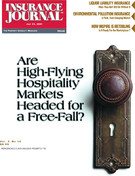Insurance companies go through life cycles just like everyone else. Birth, life, and ultimately death by absorption or bankruptcy in order to make way for new and more efficient enterprises—but two failures in one month, three in the last four? There has to be a pattern there.
First HIH, once Australia’s second largest insurer, then in quick succession, the U.K.’s Independent Insurance and Reliance Insurance go to the wall. All three were medium-sized, dynamic companies, run by flamboyant entrepreneurs who maintained they were forging new ways to provide insurance products to their customers and bottom-line value to their investors.
Ray Williams founded HIH in 1968, the same year that Saul Steinberg took control of Reliance in a leveraged buyout. Michael Bright put together Independent from Allstate’s U.K. units and Scotland’s Noble group in 1986.
There are some remarkable similarities. All three entrepreneurs were industry mavericks who gave lavish parties, sought publicity in an historically low-profile industry, and challenged old-line insurers with aggressive rate structures and innovative policies. They paid themselves and their investors a lot of money, and embarked on expanding their empires by buying other companies. Steinberg became one of the most feared corporate raiders in the ’70s and ’80s, making bold bids for Chemical Bank and Walt Disney, among other targets. Investors loved them as the money rolled in.
Their insurance peers felt otherwise, as premiums slid and the cutthroat competition for market share cut profits to the bone and raised loss ratios. Still, even after the stock market collapse in 1987 brought an end to the “go-go years,” they seemed to prosper. Until 1999, all three were profitable, but then claims began to rise—over $30 billion in insured catastrophe losses, asbestos, environmental suits, rising demands and awards in workers’ compensation, etc. Reinsurance rates rose as more rigorous underwriting standards were imposed, and investment earnings imploded with the collapse of the “new economy.”
It was the end of an era. Steinberg resigned last year as losses from the Unicover pool and other disasters began to erode Reliance’s reserves; and by August, the Pennsylvania Department of Insurance was overseeing the company.
Analysts came out of the woodwork when Independent suddenly went into liquidation, saying they’d warned about weakness in its reserves as early as 1993. But even after Bright left in April, the company was still considered solid, right up to the moment when a proposed rights offer to raise $212 million tanked, and the company stopped writing new business. The London Stock Exchange suspended its shares, a midnight court order put PricewaterhouseCoopers in charge of liquidation, and they uncovered at least $88 million in claims that had never been registered on the company’s books. More recent estimates put the amount at closer to $282 million.
Williams left HIH late last year and has been keeping a low profile ever since, but when news of the insurer’s plight began to spread, he surrendered his passport and the government has frozen his assets—including presumably his now-worthless HIH shares. The KPMG partner appointed as HIH’s provisional liquidator has seen estimates of its indebtedness go from around $416 million last March to more than $2 billion and climbing. Based on the $490 million it reportedly had as net asset surplus last fall, in a best-case scenario HIH lost at least $1.875 billion in nine months. (That has to be some kind of industry record.)
What is the pattern here? All three companies ran into trouble from over-expansion and inadequate underwriting standards, which set premiums too low. The meltdown in the stock markets, which began late last year, destroyed their investment portfolios. The mounting losses strained their capacity until it broke. Reliance and HIH were particularly vulnerable to the low premiums and increasingly higher claims of workers’ comp coverage, and both wrote a lot of business in California. All three gained market share at the expense of larger, more established carriers, but the price they paid was ultimately too high.
The overall lesson: without careful underwriting, selling insurance becomes a Ponzi scheme. You can sell lots of policies if you charge less than the other guys, but you have to keep expanding to pay off the claims and still satisfy the expectations of your investors. The more policies you sell, the more claims you’ll eventually have, and you can’t always count on low-priced reinsurance to bail you out. That can’t last forever, and when it crashes, it crashes big-time.
AIG’s legendary boss Maurice “Hank” Greenberg recently told delegates at a financial conference that his company had turned down billions of dollars that would have been unprofitable while other companies were scrambling for market share. That philosophy helps to explain why AIG is the world’s largest insurer in terms of equity capital, while the companies headed by Steinberg, Bright and Williams are essentially gone.
Charles E. Boyle is Insurance Journal’s International Editor, residing in Paris. He can be reached via e-mail at ijwest@insurancejournal.com.
Topics Claims
Was this article valuable?
Here are more articles you may enjoy.


 Florida’s Slide Insurance Secures $210 Million Catastrophe Bond
Florida’s Slide Insurance Secures $210 Million Catastrophe Bond  DeSantis Signs Bill Barring Local Worker Heat Protection Measures
DeSantis Signs Bill Barring Local Worker Heat Protection Measures  Florida Peninsula Says Reforms Have Had an Impact, Announces 2% Rate Cut
Florida Peninsula Says Reforms Have Had an Impact, Announces 2% Rate Cut  US Dog-Related Injury Claims Hit $1.12 Billion in 2023: Triple-I, State Farm Report
US Dog-Related Injury Claims Hit $1.12 Billion in 2023: Triple-I, State Farm Report 


